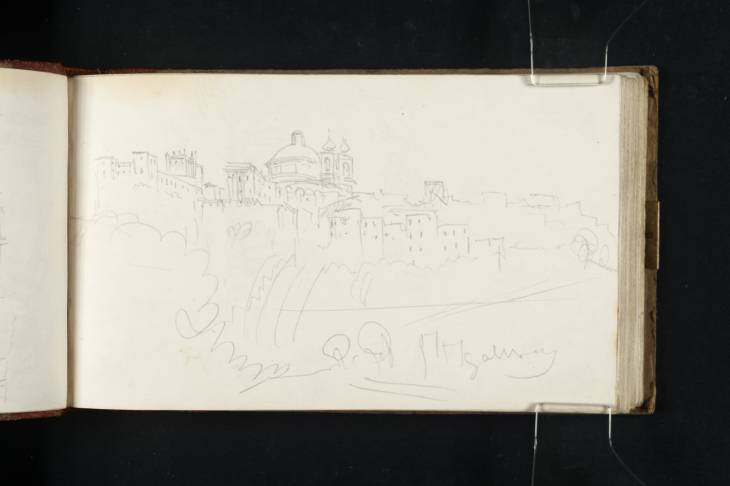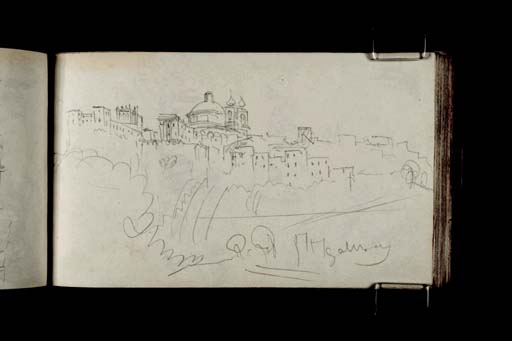Joseph Mallord William Turner The Palazzo Chigi and the Church of Santa Maria dell'Assunzione, Ariccia 1819
Image 1 of 2
Joseph Mallord William Turner,
The Palazzo Chigi and the Church of Santa Maria dell'Assunzione, Ariccia
1819
Joseph Mallord William Turner 1775–1851
Folio 83 Verso:
The Palazzo Chigi and the Church of Santa Maria dell’Assunzione, Ariccia 1819
D15455
Turner Bequest CLXXXII 82 a
Turner Bequest CLXXXII 82 a
Pencil on white wove paper, 113 x 189 mm
Inscribed by the artist in pencil ‘[?gallery]’ bottom right
Accepted by the nation as part of the Turner Bequest 1856
References
1909
A.J. Finberg, A Complete Inventory of the Drawings of the Turner Bequest, London 1909, vol.I, p.539, as ‘The church of the Assunzione della Vergine, at L’Ariccia, with the palace of the Chigi’.
1984
Cecilia Powell, ‘Turner on Classic Ground: His Visits to Central and Southern Italy and Related Paintings and Drawings’, unpublished Ph.D thesis, Courtauld Institute of Art, University of London 1984, pp.194 note 102, 195, 497 note 106, reproduced pl.119, as ‘The Palazzo Chigi and S. Maria dell’Assunzione, Ariccia’.
1987
Cecilia Powell, Turner in the South: Rome, Naples, Florence, New Haven and London 1987, pp.18, [88] note 78, reproduced p.[88] pl.90, as ‘Ariccia: Palazzo Chigi and S. Maria dell’Assunzione’.
The subject of this sketch is Ariccia, one of the sixteen ‘Castelli Romani’ communes just outside of Rome which sits on a hill above a wooded valley between Lakes Albano and Nemi. According to classical mythology it was the favoured hunting ground of the Roman goddess Diana and this, along with its picturesque location, celebrated architecture, and rich historical heritage, made it an established destination for tourists. It was also a popular subject for landscape artists. Turner would have associated the town with the work of Gaspard Dughet (also known as Gaspard Poussin) and Richard Wilson, and may also have been familiar with depictions by contemporary British watercolourists such as Thomas Jones, Francis Towne and John ‘Warwick’ Smith.
On this page Turner records a view well-known to landscape artists in the eighteenth and nineteenth centuries, the town seen from the road beneath the escarpment to the north-west. Turner had made a swift notational drawing of the topography on the previous page, see folio 83 (D15454; Turner Bequest CLXXXII 82) but this drawing contains more accurate architectural detail of the Palazzo Chigi on the left and Bernini’s Church of Santa Maria dell’Assunzione on the right. This viewpoint was a popular one and the composition exactly repeats that chosen by many other artists.1 Turner himself had copied a view after John ‘Warwick’ Smith’s in the Italian Guide Book sketchbook (see Tate D13968; Turner Bequest CLXXII 20). He had also depicted it in his illustration, La Riccia, (Sterling and Francine Clark Art Institute, Williamstown, Massachusetts) based on a drawing by James Hakewill, engraved by John Pye and published in Picturesque Tour of Italy, 1819.2 For another sketch of a similar view see also the Naples, Paestum, Rome sketchbook (Tate D15939; Turner Bequest CLXXXVI 16a). The prospect as Turner saw it was altered in 1854 when Pope Pius IX ordered the building of a bridge across the wooded valley from Albano.
Turner made several sketches of Ariccia, see folios 18 verso, 83–85 and 86 verso-88 (D15328, D15454–D15458 and D15460–D15463; Turner Bequest CLXXXII 82–85 and 86a–87).
Nicola Moorby
May 2008
For example, Richard Wilson, Ariccia circa 1754–6, chalk and pencil on white wove paper Tate T08164; Francis Towne, Ariccia 1781, watercolour on white wove paper (British Museum); John ‘Warwick’ Smith, Ariccia, Palazzo Chigi, pencil and watercolour on white wove paper, Tate T08484; Corot, Ariccia, Palazzo Chigi 1826–7, oil on canvas, Museum Langmatt, Baden, Switzerland. See also a drawing by Charles Joseph Lecointe, see Francesco Petrucci e Susanna Marra, Vedute dei Colli Albani e di Roma dall’album di viaggio di Charles Joseph Lecointe (1824–1886), exhibition catalogue, Palazzo Chigi, Ariccia 2006, no.15, p.33, reproduced.
How to cite
Nicola Moorby, ‘The Palazzo Chigi and the Church of Santa Maria dell’Assunzione, Ariccia 1819 by Joseph Mallord William Turner’, catalogue entry, May 2008, in David Blayney Brown (ed.), J.M.W. Turner: Sketchbooks, Drawings and Watercolours, Tate Research Publication, December 2012, https://www


